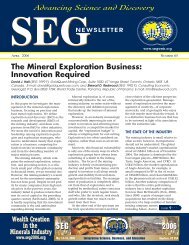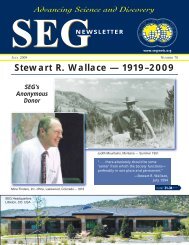SEG 45 Final_qx4 - Society of Economic Geologists
SEG 45 Final_qx4 - Society of Economic Geologists
SEG 45 Final_qx4 - Society of Economic Geologists
Create successful ePaper yourself
Turn your PDF publications into a flip-book with our unique Google optimized e-Paper software.
<strong>SEG</strong> NEWS<br />
20 <strong>SEG</strong> NEWSLETTER No 63 • OCTOBER 2005<br />
Editor’s note: Part I <strong>of</strong> the report on the gold forum, covering Carlin-type deposits, was written by Greg Arehart and appeared in the<br />
July Newsletter. This second part, on the Witwatersrand, was contributed by Laurence Robb.<br />
A large audience <strong>of</strong> several hundred<br />
attended the much-anticipated debate<br />
on the origin <strong>of</strong> the Witwatersrand gold<br />
and uranium deposits in South<br />
Africa…testimony to the fascination<br />
that this mother <strong>of</strong> all gold fields still<br />
holds for the economic geology community<br />
at large. Ironically, it was a<br />
hydrothermal quartz vein in the West<br />
Rand Group near Roodepoort from<br />
which the very first gold was extracted<br />
in the Wits Basin….this was by the<br />
Streuben brothers a few years prior to<br />
the discovery <strong>of</strong> conglomerate-hosted<br />
gold, on the Ridge <strong>of</strong> White Waters, by<br />
George Harrison and George Walker in<br />
1886.<br />
Right from the very beginnings <strong>of</strong><br />
mining, it was clear that an understanding<br />
<strong>of</strong> the occurrence <strong>of</strong> gold, and<br />
its origin, was no simple matter. As<br />
long ago as 1917, Robert Burns Young,<br />
in his book The Banket <strong>of</strong> South African<br />
Gold Fields, described the authigenic<br />
character <strong>of</strong> gold within what was<br />
clearly a fossilized, heavy mineral-bearing<br />
gravel placer. And so it is, still in<br />
the year 2005, that geologists continue<br />
to argue about the nature <strong>of</strong> the gold<br />
and its origin, either as detrital particles<br />
sourced from a hinterland that must<br />
itself have been fabulously rich in primary<br />
gold deposits, or hydrothermal<br />
precipitates from a fluid—it, too, either<br />
very voluminous or extraordinarily<br />
enriched in the precious metal.<br />
The Reno debate started <strong>of</strong>f with a<br />
talk by Hartwig Frimmel, who presented<br />
the case for the modified placer point <strong>of</strong><br />
view. This notion is based on the existence<br />
in the basin <strong>of</strong> flat, rounded and<br />
“peened” grains that are interpreted as<br />
detrital gold toroids. This gold was initially<br />
concentrated by hydrodynamic<br />
processes during sedimentation and<br />
then substantially dissolved and remobilized<br />
by later fluids flowing through<br />
the sediments. It was shown that there<br />
must have been at least 2 episodes <strong>of</strong><br />
fluid flow, resulting in the re-precipitation<br />
<strong>of</strong> gold and pyrite as authigenic<br />
particles within the conglomerates. The<br />
argument in favor <strong>of</strong> a purely<br />
<strong>SEG</strong> Forum on Gold Deposits: Part II<br />
May 14, 2005 • Reno, Nevada<br />
Laurence J. Robb (<strong>SEG</strong> 1985 F) Greg B. Arehart (<strong>SEG</strong> 1988 F)<br />
Report on the Witwatersrand Debate<br />
hydrothermal introduction <strong>of</strong> gold was<br />
presented by Neil Phillips, whose model<br />
invokes early circulation <strong>of</strong> diagenetic/meteoric<br />
fluids with hydrocarbon<br />
generation, followed by a pre-Platberg<br />
(the Platberg volcanics form part <strong>of</strong> the<br />
flood basaltic succession that immediately<br />
overlies the Witwatersrand sediments<br />
at 2709 Ma) introduction <strong>of</strong><br />
metamorphogenic fluid that sulfidized<br />
the “black sand” heavy mineral suite<br />
that had accumulated during sedimentation<br />
and also precipitated gold. The<br />
essential differences between the 2 viewpoints<br />
are that the modified placer<br />
model requires initial accumulation <strong>of</strong><br />
detrital gold grains, with later modification,<br />
whereas the hydrothermal model<br />
does not recognize the presence <strong>of</strong> allogenic<br />
gold and mineralization is essentially<br />
by precipitation from a fluid<br />
phase.<br />
What followed these two presentations<br />
was a combination <strong>of</strong> audience<br />
questions and comments, interspersed<br />
with brief presentations by each <strong>of</strong> five<br />
panel members, themselves experts on<br />
the Witwatersrand Basin. David Groves<br />
initiated the discussion by questioning<br />
the discrepancy between the very large<br />
scale alteration halos around putative<br />
fluid conduits and the mineralization<br />
that occurs at a more limited scale and<br />
is restricted to the thin conglomerate<br />
horizons. He also posed the question as<br />
to what exactly was the hydrothermal<br />
model, pointing out that its proponents<br />
did not seem to agree on the timing <strong>of</strong><br />
the principal ore fluid circulation event.<br />
John Chesley also spoke in favor <strong>of</strong> a<br />
detrital origin <strong>of</strong> gold by summarizing<br />
the recent Re-Os isotope dating and<br />
characterization <strong>of</strong> gold and pyrite in<br />
the basin. This data, although itself<br />
controversial—as pointed out by<br />
Jonathan Law—is interpreted to indicate<br />
an unusual mantle source for the<br />
gold and its introduction as detrital particles<br />
at a time that preceded the end <strong>of</strong><br />
sedimentation in the basin. Proponents<br />
<strong>of</strong> the hydrothermal view, such as Andy<br />
Barnicoat, re-emphasized the ubiquity<br />
<strong>of</strong> alteration assemblages and pointed<br />
to evidence showing that the latter are<br />
intimately associated with both gold<br />
and uraninite, <strong>of</strong>ten in fractures within<br />
the conglomerate packages. Vic Wall<br />
provided evidence for a fluid circulation<br />
and mineralizing event in post-<br />
Transvaal times (i.e., later than ca.<br />
2550 Ma) and drew interesting analogies<br />
between the Au-U-C-PGM association<br />
in the Witwatersrand and a similar<br />
association in Proterozoic unconformity-related<br />
uranium deposits.<br />
Audience participation was lively<br />
and the four hours allocated to the<br />
debate passed by in a flash. No vote<br />
was taken at the end <strong>of</strong> proceedings<br />
and it is difficult to say which way the<br />
body <strong>of</strong> opinion swayed. Is there more<br />
consensus now about the origin <strong>of</strong> this<br />
most enigmatic <strong>of</strong> deposits than there<br />
was in the past? The answer is probably<br />
yes, in that more is known about the<br />
processes involved and also because<br />
proponents <strong>of</strong> the two models do agree<br />
on a wide range <strong>of</strong> issues. A fundamental<br />
division, nevertheless, still remains—<br />
namely, that <strong>of</strong> whether a fertile hinterland<br />
existed from which pyrite, gold,<br />
and uraninite detritus was sourced. The<br />
morphology <strong>of</strong> grains is not sufficient,<br />
in the view <strong>of</strong> some, to provide a conclusive<br />
answer to this question.<br />
Hundreds <strong>of</strong> zircons have now been<br />
individually dated and provide<br />
unequivocal indications <strong>of</strong> the age and<br />
location <strong>of</strong> the source <strong>of</strong> clastic sediment<br />
in the depository. The eventual<br />
answers to the Witwatersrand debate<br />
may also have to come from well-constrained<br />
and more accurate ages <strong>of</strong> key<br />
minerals such as pyrite, uraninite, and<br />
gold. The writer for one is fervent in the<br />
hope that we will have such answers<br />
well before the last bucket <strong>of</strong> ore is<br />
extracted from this phenomenal set <strong>of</strong><br />
deposits. 1






